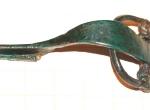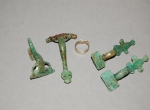Czarnówko
Czarnówko, Lębork district. A small cemetery from the →Migration Period situated within one of the largest Pre-Roman Period and Roman Period grave sites recorded in Central Europe, established in the valley of the river Łeba (to the north-west of today’s Lębork) in the period 2nd century BC - 3rd century AD. Identified in 1972, the site came under a rescue excavation in 1973 and continued to be investigated, on and off, until 2000. It was fully excavated during a regular excavation made in 2008-2015. Around AD 450, approximately after a break of two centuries, the site of the no longer used Roman Period burial ground was occupied by a small →Migration Period cemetery with inhumation graves. Three of them have a reliable dating, three others were attributed to the same cemetery by indirect evidence only. The assorted materials present in the grave inventories are an excellent illustration of the disintegration of the cultural structures in Central Europe at the end of Antiquity.
A brooch present in one of the grave inventories is a type Ramersdorf (Fig. 1), according to current findings, of Scandinavian origin; in Poland similar brooches form a concentration in Great Poland, mostly around Poznań. Chronologically, type Ramersdorf is confined to the 5th century at large, but is thought to come into use only around the middle of that century.
A pair of bow brooches from another grave inventory (Fig. 2) have the largest number of analogies in Scandinavia and Anglo-Saxon England, with only a single specimen recorded in Poland so far (Radziejów Kujawski, Radziejów district). Typologically these brooches belong in the group West Heslerton/Weimar/Brunnhem, a simplified version of 5th-century Scandinavian relief brooches with a rectangular head, or possibly, to the related Anglo-Saxon great square-headed brooches. The group is dated to the second half of the 5th century. The same grave contained a brooch with a false spring and chord cast in one piece with the bow (Figure 2). This form has a modest number of analogies in finds that range from western Finland all the way to Kent in England, with the largest concentration on Bornholm. These brooches have two springs – a true spring over which there is a false spring decoration. Their form suggests that an attempt was made to adjust the brooch forms of the Late Roman Period to suit the new fashion in bow brooches introduced on the threshold of the Merovingian period. This particular grave inventory from Czarnówko has a dating of c. AD 500. Next to the already described artefacts it included a brooch with an openwork foot terminal; two other graves contained ordinary crossbow brooches.
The →Migration Period cemetery at Czarnówko is one of a small cluster of settlements dated to the second half of the 5th century recorded between the Łupawa and the Łeba rivers, to the south of Lake Łebsko, which may be attributed to arrivals from south Scandinavia. The special significance of this group is illustrated by the fact that the region of Pomerania to the west of the river Vistula was almost fully depopulated during this period.
JS
Literature: H. Machajewski, Skandynawskie elementy kulturowe na Pomorzu Zachodnim z okresu wędrówek ludów (2 połowa IV w. – początek VI w.), Przegląd Archeologiczny, vol. 40, 1992, p. 71-96; H. Machajewski, Dwa cmentarzyska z późnego okresu rzymskiego i wczesnej fazy okresu wędrówek ludów oraz z późnej fazy okresu wędrówek ludów na stanowisku 1 w Głuszynie, woj. słupskie, Folia Praehistorica Posnaniensia, vol. VII, 1995, p. 155-235; M. Schulze-Dörrlamm, Romanisch oder germanisch? Untersuchungen zu den Armbrust- und Bügelknopffibeln des 5. und 6. Jahrhunderts n. Chr. aus den Gebieten westlich des Rheins und südlich der Donau, Jahrbuch des Römisch-Germanischen Zentralmuseums Mainz, vol. 33, 1986, p. 593-720; J. Schuster, Przybysze ze Skandynawii – małe cmentarzysko z okresu wędrówek ludów, [in:] J. Andrzejowski (ed.), Czarnówko, stan. 5. Cmentarzyska z późnej starożytności na Pomorzu. Część 1, Monumenta Archaeologica Barbarica, Series Gemina IV, Lębork-Warszawa (in print); A. Bursche, J. Kowalski (ed.), Barbarzyńskie Tsunami - Okres Wędrówek Ludów w dorzeczu Odry i Wisły, Warszawa-Szczecin 2017.
-
 full resolution
full resolution
Fig. 1. Brooch – type Ramersdorf (photo by J. Schuster).
-
 full resolution
full resolution
Fig. 2. Brooches from an inhumation grave: at left, a form with a false spring and chord cast in one piece with the bow, at right, a pair of bow brooches, group West Heslerton/Weimar/Brunnhem (photo by A. Krzysiak).


